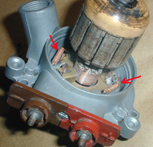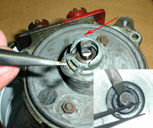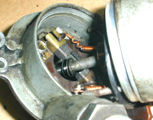Determine first if the pump runs by testing with 12 VDC . A battery or charger will work just fine or any power supply that will deliver 12 VDC at least 5 Amperes. Care here that the pump does not eject gasoline creating a dangerous situation.
Apply penetrating lube to the fasteners and let sit
overnight if possible.
Mark the motor can relative to the brush housing, and the bottom cover.
Use a deep scribe or a center-punch. If you get the motor can rotated on
re-assembly the pump will run in reverse.
Using a good, sharp slotted screwdriver remove the bottom plate. If the screws are corroded in place either tap the back of the driver with a hammer a few times or use a hand held impact driver. If you are using an impact driver I have found it works to use a good size hammer and hit the driver gently several times. You will see the head turn slightly for each tap. Breaking a screw happens.
Tap the bottom cover with a plastic hammer to remove. You may need to carefully pry at the seam for a while with a sharp blade. If you raise burs they can be removed later.
When the cover is removed you will see the turbine and cover o-ring seal. Remove the turbine and note that the pointed end of its blades point toward the pump, not the bottom cover plate. If you get this wrong on re-assembly, the pump pressure will be low. Note also the missing blades on this one. It cannot be reused.
The turbine generally does not come off easily and it is fragile! Try using two hooks to rock it off the motor drive shaft. If it's stuck because the gasoline has jelled try this; Fill a saucepan with water and a little laundry detergent enough to cover the bottom of the pump. I let the soapy water come to a boil, reduce heat and simmer for 30 minutes. The soup reeks. You'll get booted out of the kitchen. Also discolors the casting a little.
The pump will be hot when you remove it. Use care that the turbine does not fall off and break. I've had to cook these pumps outside on a hotplate sometimes for an hour to remove the jell and turbine
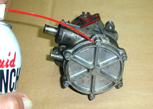
.
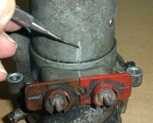
.
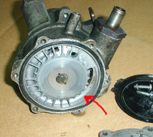
.
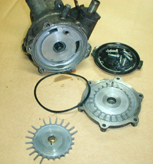
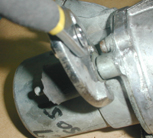 .
.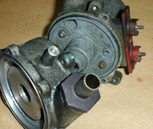 .
.